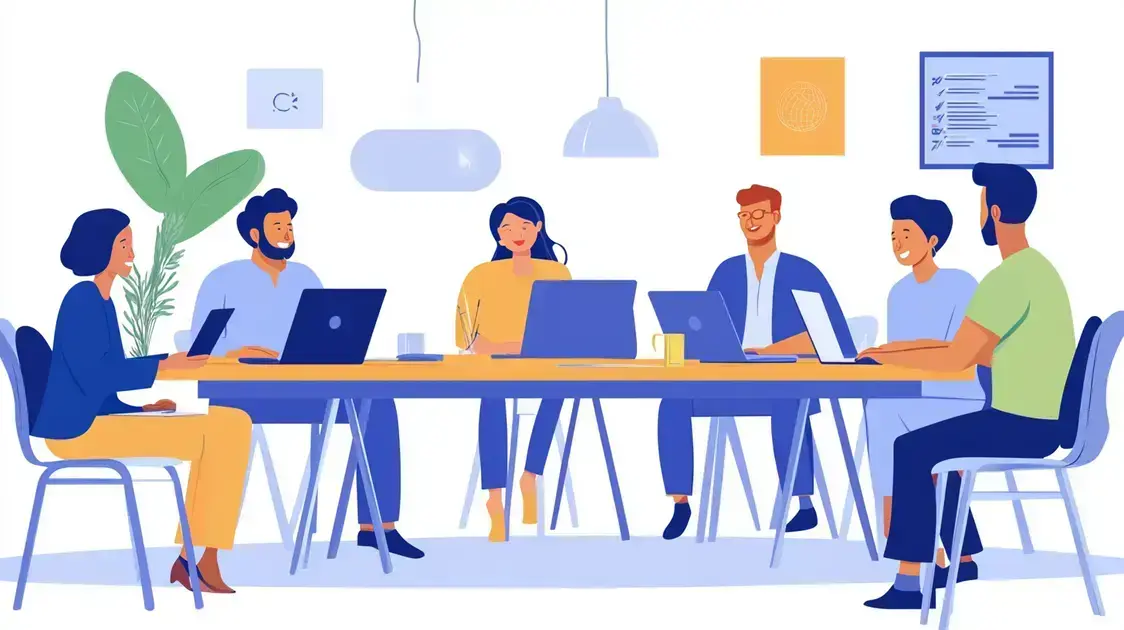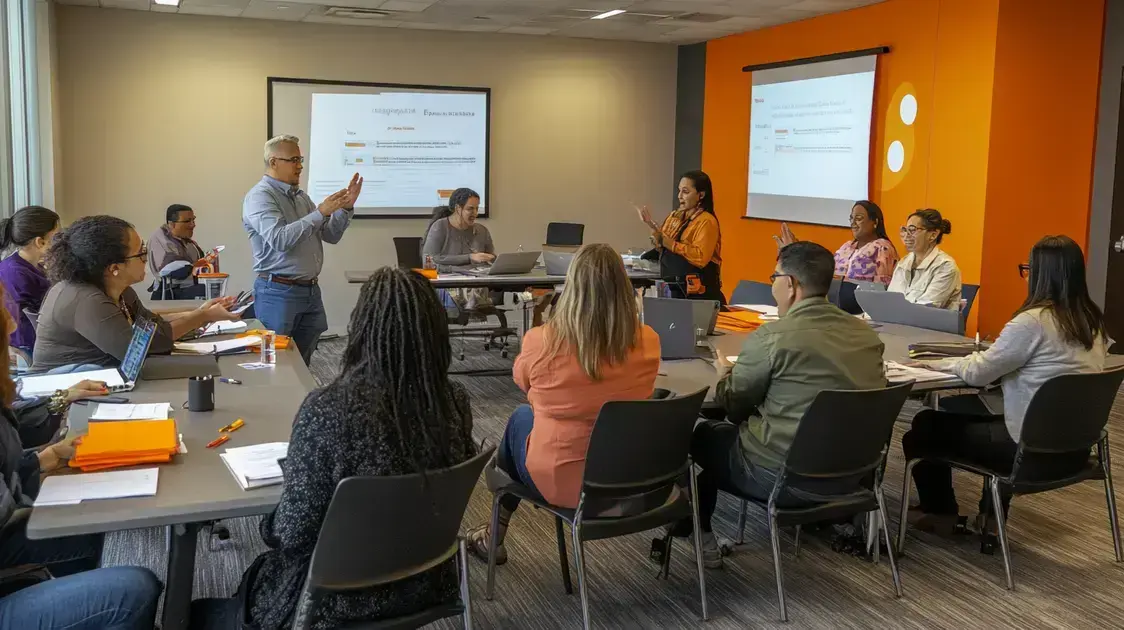Workplace skills enhancement is crucial in today’s fast-paced job market. Whether you’re just starting or aiming for a promotion, improving your skills can boost your career. Recognizing what to focus on can set you up for long-term success.
It’s not just about technical abilities—soft skills like communication and problem-solving are equally important. Developing these skills makes you more adaptable and valuable in any role.
Want to learn how to enhance your workplace skills? Keep reading to discover practical tips and strategies for growth.
Understanding Workplace Skills
Workplace skills refer to the abilities and competencies that help individuals perform effectively in their jobs. Understanding these skills is crucial for employees seeking to improve their performance and advance their careers.
Various skills are essential in today’s dynamic work environment, and recognizing them can set you on the path to personal and professional growth through workplace skills enhancement.
Types of Workplace Skills
Workplace skills can be categorized into three main types: hard skills, soft skills, and transferable skills. Hard skills are specific, teachable abilities, such as proficiency in software applications, technical expertise, or data analysis.
Soft skills, on the other hand, involve interpersonal attributes like communication, teamwork, and problem-solving. Transferable skills are those that can be applied across different jobs and industries, making them valuable in various contexts, contributing to workplace skills enhancement.
Why Understanding Skills is Important
Grasping the types of skills you possess helps you identify areas for improvement. It allows you to align your skillset with job requirements and demonstrates adaptability to potential employers. Furthermore, enhancing skills can lead to increased productivity, better job satisfaction, and greater opportunities for advancement.
Identifying Your Skills
To understand your workplace skills, take time to reflect on your experiences and gather feedback from colleagues or supervisors. You can create a skills inventory by listing both hard and soft skills, evaluating your strengths and weaknesses.
Utilizing online assessment tools and career resources also helps in identifying vital skills. Many platforms offer free assessments that measure various competencies, aiding in your skills enhancement journey.
The Importance of Skills Enhancement
Benefits of Skills Enhancement
Enhancing your skills can lead to numerous benefits. It increases your employability, making you more attractive to potential employers. Additionally, acquiring new skills can result in higher job satisfaction and better job security as you become more valuable in your role. This can also open avenues for career advancement, contributing to workplace skills enhancement.
Keeping Up with Industry Trends
Industries are rapidly changing due to innovations and market demands. By focusing on skills enhancement, you can stay current with industry trends. This ensures that your knowledge and abilities are relevant, allowing you to meet the needs of your employer and contribute meaningfully to your team.
Fostering a Growth Mindset
Engaging in skills enhancement fosters a growth mindset, which is crucial for long-term success. When you embrace learning, you become more open to new ideas and approaches. This resilience allows you to tackle challenges more effectively and find creative solutions to problems that may arise in your work.
Building Professional Networks
Participating in skills enhancement programs often facilitates networking opportunities. As you learn alongside coworkers and industry peers, you can forge valuable connections that might benefit your career in the future. These relationships can provide support and open doors for collaborations and new opportunities.
Effective Communication in the Workplace

Effective communication in the workplace is vital for fostering a positive and productive environment. Clear communication helps avoid misunderstandings and builds strong relationships among coworkers.
It is essential for collaboration, ensuring that everyone is on the same page and working towards common goals. Workplace skills enhancement is closely tied to the ability to communicate effectively, as it plays a significant role in ensuring seamless interactions.
Key Elements of Effective Communication
There are several key elements that contribute to effective communication in the workplace:
- Active Listening: This means fully concentrating, understanding, and responding to what others say.
- Clarity and Conciseness: Be clear and direct to ensure your message is understood. Avoid using jargon or overly complicated language.
- Nonverbal Communication: Body language, eye contact, and facial expressions play a significant role in conveying messages.
- Empathy: Understanding and being sensitive to the feelings of others encourages open dialogue and trust.
The Role of Feedback
Giving and receiving feedback is crucial for effective communication. Constructive feedback helps individuals improve their performance, while positive reinforcement boosts morale. Create an environment where giving and receiving feedback is normal and encouraged, supporting continuous workplace skills enhancement.
Utilizing Different Communication Channels
In today’s workplace, various communication channels exist, such as email, instant messaging, and video calls. Choosing the right channel depends on the message’s urgency and complexity. Always consider what medium will be the most effective for your communication.
Building a Communication Culture
Organizations should promote a culture of open communication. Encourage team meetings, brainstorming sessions, and regular check-ins. This approach makes everyone feel valued and promotes transparency within the team.
Time Management Strategies
Prioritization
One of the most effective time management strategies is prioritization. Start by making a list of tasks and rank them based on importance and urgency. This helps you focus on what needs to be done first and prevents you from getting sidetracked by less important tasks.
The Pomodoro Technique
The Pomodoro Technique is a popular method where you work for a set period, typically 25 minutes, followed by a short break of 5 minutes. After completing four cycles, take a longer break of 15 to 30 minutes. This technique helps maintain focus and reduces burnout.
Setting SMART Goals
Using the SMART criteria can enhance your goal-setting process. Ensure your goals are Specific, Measurable, Achievable, Relevant, and Time-bound. This approach provides clear direction and makes it easier to track progress.
Utilizing Technology Tools
There are many time management apps available that can help track tasks and deadlines. Tools like calendars, to-do lists, and project management software can keep you organized and remind you of upcoming deadlines.
Avoiding Multitasking
While multitasking may seem productive, it can often lead to errors and decreased efficiency. Instead, focus on completing one task at a time. This will help you maintain higher quality work and finish tasks more quickly.
Team Collaboration Techniques
Team collaboration techniques are essential for enhancing productivity and ensuring that teams work well together. By employing effective strategies, team members can communicate better, share ideas, and achieve their goals more efficiently.
Establishing Clear Roles
Each team member should have a clear understanding of their role and responsibilities within the team. Clearly defined roles prevent confusion and ensure accountability, allowing everyone to focus on their specific tasks.
Encouraging Open Communication
Open lines of communication foster a collaborative environment. Encourage team members to share their thoughts, ideas, and feedback openly. Regular team meetings and one-on-one check-ins can enhance communication and keep everyone informed.
Utilizing Collaboration Tools
Using collaboration tools can make teamwork more efficient. Applications like Slack, Microsoft Teams, and Trello facilitate communication, task management, and project tracking. Choose tools that fit your team’s needs and ensure everyone is trained to use them effectively.
Setting Common Goals
Aligning the team around shared objectives enhances collaboration. Setting common goals provides a clear sense of direction and unifies the team. Regularly review progress on these goals to ensure that everyone stays on track and motivated.
Fostering a Team Culture
A positive team culture is vital for collaboration. Encourage team-building activities and social interactions to strengthen relationships. When team members feel connected, they are more likely to cooperate and support one another.
Continuous Learning and Development

Continuous learning and development in the workplace is crucial for personal and professional growth. In today’s fast-paced environment, staying up-to-date with new skills and trends can make a significant difference in your career success.
Benefits of Continuous Learning
Engaging in lifelong learning enhances your knowledge and skills, making you more competent in your role. It can lead to increased job satisfaction, as employees feel more confident in their abilities. Additionally, continuous learning helps you adapt to changes in your industry and can create opportunities for advancement.
Ways to Promote Continuous Learning
Employers can support continuous learning by offering training programs, professional development courses, and workshops. Encourage employees to pursue relevant certifications or attend conferences related to their field.
Creating a Learning Culture
Fostering a culture that values learning encourages employees to take the initiative in their development. Recognize and reward employees who engage in learning activities, and provide resources that make learning easily accessible. This can include an online learning platform with courses tailored to your organization’s needs.
Setting Personal Learning Goals
Individuals should also take ownership of their learning journey. Set specific, measurable goals for what you want to learn and how you will achieve it. Regularly review your progress and make adjustments as necessary to stay on track.
Networking and Sharing Knowledge
Encourage team members to share their knowledge and experiences with one another. By collaborating and learning from each other, employees can gain insight into different perspectives and techniques, further enriching the learning environment.
Assessing Your Skills Progress
Assessing your skills progress is a vital aspect of workplace skills enhancement. Regular evaluation of your skills allows you to identify areas where you excel and those that need improvement. This understanding can help shape your career development path.
Setting Benchmarks
Start by establishing clear benchmarks for your skills. These benchmarks will serve as a reference point for your progress. Determine what skills are essential for your role and set specific, measurable goals.
Regular Self-Assessments
Conducting regular self-assessments can help you gauge your improvement over time. Create a checklist of skills to evaluate, and honestly reflect on your proficiency. Consider keeping a journal to track your progress and insights.
Seeking Feedback
Obtaining feedback from coworkers, supervisors, or mentors can provide valuable insights into your skills. Ask for constructive criticism and suggestions for improvement. This feedback can help you identify blind spots and encourage growth.
Utilizing Assessment Tools
Many online tools and resources can help you assess your skills. Consider taking skills assessments or quizzes tailored to your role or industry. These tools can offer feedback on your strengths and areas for development.
Tracking Your Learning Experiences
Document your learning experiences and how you’ve applied new skills in your work. Keeping a record of courses attended, certifications earned, and projects completed will demonstrate your commitment to growth.
In Conclusion: Unlocking Your Potential Through Workplace Skills Enhancement
Enhancing workplace skills is a continuous journey that requires commitment, adaptability, and a proactive approach. By understanding essential skills, prioritizing their development, and embracing effective communication, collaboration, and time management techniques, professionals can significantly elevate their performance.
Moreover, fostering a culture of continuous learning and regularly assessing skills progress helps individuals and teams stay competitive in today’s fast-paced environment. With the right strategies in place, everyone has the potential to unlock new career opportunities and achieve greater job satisfaction.
Taking these steps not only benefits the individual but also contributes to a more engaged and successful organization.